- What are Eyelid Malpositions?
- What is Tear Duct Obstruction?
- What is Thyroid-Related Eye Disease?
- What is Blepharospasm?
- What is oculoplastic aesthetic surgery?
- What is the difference between an Oculoplastic Surgeon and a Cosmetic/Plastic surgeon?
What are Eyelid Malpositions?
There are many eyelid problems that can be present at birth or that can result from injuries or aging. Examples include:
What is Tear Duct Obstruction?
In the normal eye, tears are formed in the lacrimal gland. The tears lubricate, protect and "wash" the eye before being drained away. If the tear drainage systems are blocked, tears overflow and the tear sac becomes susceptible to infection (Dacryocystitis) , which may spread to the surrounding ocular tissues and the eyeball itself.
Fortunately, this condition is treatable. Blocked tear drainage systems can be opened and a bypass system can be created. Tear duct surgery is performed by a trained Oculoplastic and Lacrimal surgeon through a small incision in the corner of the eye, or with endoscopic surgery (with a tiny microscope) through the nose. This latter approach is advantageous because it avoids an external skin incision (thus there is no scar), involves less bleeding, and allows faster recovery and return to normal activities.
What is Thyroid-Related Eye Disease?
A condition called Dysthyroid Ophthalmopathy or Graves' disease may cause the eyes to bulge forward (Exophthalmos) and the eyelids to become puffy or to retract(lagophthalmos), making the eyes appear larger.
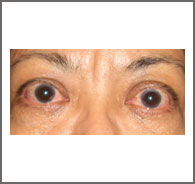
This condition may result in double vision, severe inflammation, discomfort, dry or watery eyes, corneal abrasions, infections, and possibly loss of vision. If necessary, surgery for thyroid eye disease may involve expanding the bones of the eye socket to allow the bulging eye to fall back. Muscle surgery can then be performed to alleviate double vision. Finally, eyelid surgery is performed as the last stage of treatment whereby the eyelids are lowered. This will yield a more natural, pleasing appearance and reduce the risk of eye-related complications.
What is Blepharospasm?
When repeated involuntary eyelid muscle contractions produce a disturbing winking motion,this muscle disorder can disrupt normal vision as to make simple but necessary activities such as reading, using the computer, watching TV, and driving difficult or even impossible to perform. This can be treated with localized injections of BOTOX®, a substance that relaxes the muscle for three to six months. BOTOX® injection is a short, 15-minute procedure but carries minor risks, so it is important to choose a physician who is experienced with BOTOX® and very knowledgeable about the eyes and their surrounding anatomy.
What isoculoplastic aesthetic surgery?
Modern surgical techniques can restore your eyes' bright, healthy appearance, repair damage caused by aging, accidents or disease, or reconstruct birth defects. The normal aging process often causes the loss of skin elasticity, loosening of the lid skin and drooping of the brows and lids. Eyelid surgery (blepharolasty) can lessen the aging changes by removing the excess eyelid skin and eliminating puffiness around the eyes.

Pre and Post Operation Upper Lids
Whether as the result of aging, disease or injury, many stand to benefit from oculoplastic reconstructive surgery. Blind or dysfunctional eyes can be replaced with orbital implants and prosthetic eyes that look close to normal. Trauma which has damaged the eyelids, cheeks, or orbital bones (orbital fractures) can also be reconstructed.
The eye socket may be subjected to certain injuries, tumors, and congenital abnormalities that can be corrected with surgery. Tumor growths within the eye socket and periocular tissues may also be treated by Oculoplastic surgeons by excision and reconstruction of the resulting eyelid and periocular tissue defects
What is the difference between an Oculoplastic Surgeon and a Cosmetic/Plastic surgeon?
Oculoplastic surgeons combine advanced training in ophthalmology with specialization in plastic and reconstructive surgery. Unlike cosmetic or plastic surgeons, Oculoplastic surgeons have undergone additional training in Ophthalmology. Thus they are more cognizant of and attentive to the anatomic and functional aspects of surgery around the eyes and eyelids, aside from the aesthetic aspect. They combine in-depth knowledge of the eye with expertise in reconstructive surgery.
Oculoplastic surgery is performed on children and adults to correct or treat disorders of the eyelids, tear production and drainage (lacrimal) system, brows, the area of the face adjacent to the eye, and the bones around the eye. Also known as eye plastic or oculo-facial surgeons, they also perform cosmetic surgery and procedures that seek to restore function of the eyelids and eye socket and enhance the appearance of patients.
There are many eyelid problems that can be present at birth or that can result from injuries or aging. Examples include:
- Ptosis - the drooping of the upper lid which can be in-born (congenital) or acquired, due to infection, nerve weakness, trauma, or aging.

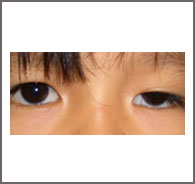
- Entropion - the turning in of the lower lid
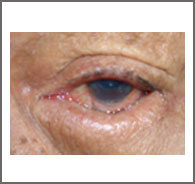
- Ectropion - the turning out of the lower lid Both entropion and ectropion can be caused by infections, trauma, burns, and the loosening of the lids due to aging.
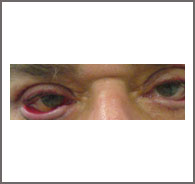
- Dermatochalasia (excessive eyelid skin) results primarily from the natural aging process. Through the passage of time, the skin looses its elasticity and firmness allowing the natural forces of gravity to pull it downward. This leads to the drooping of the upper lid skin, which may hang over the eyelashes and obstruct vision. Even if the eye is normal, the patient may complain of vision that is dim or that something is obstructing his/her vision.
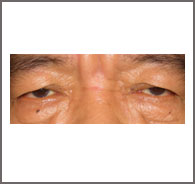
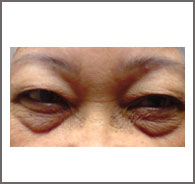
What is Tear Duct Obstruction?
In the normal eye, tears are formed in the lacrimal gland. The tears lubricate, protect and "wash" the eye before being drained away. If the tear drainage systems are blocked, tears overflow and the tear sac becomes susceptible to infection (Dacryocystitis) , which may spread to the surrounding ocular tissues and the eyeball itself.

Fortunately, this condition is treatable. Blocked tear drainage systems can be opened and a bypass system can be created. Tear duct surgery is performed by a trained Oculoplastic and Lacrimal surgeon through a small incision in the corner of the eye, or with endoscopic surgery (with a tiny microscope) through the nose. This latter approach is advantageous because it avoids an external skin incision (thus there is no scar), involves less bleeding, and allows faster recovery and return to normal activities.
What is Thyroid-Related Eye Disease?
A condition called Dysthyroid Ophthalmopathy or Graves' disease may cause the eyes to bulge forward (Exophthalmos) and the eyelids to become puffy or to retract(lagophthalmos), making the eyes appear larger.

This condition may result in double vision, severe inflammation, discomfort, dry or watery eyes, corneal abrasions, infections, and possibly loss of vision. If necessary, surgery for thyroid eye disease may involve expanding the bones of the eye socket to allow the bulging eye to fall back. Muscle surgery can then be performed to alleviate double vision. Finally, eyelid surgery is performed as the last stage of treatment whereby the eyelids are lowered. This will yield a more natural, pleasing appearance and reduce the risk of eye-related complications.
What is Blepharospasm?
When repeated involuntary eyelid muscle contractions produce a disturbing winking motion,this muscle disorder can disrupt normal vision as to make simple but necessary activities such as reading, using the computer, watching TV, and driving difficult or even impossible to perform. This can be treated with localized injections of BOTOX®, a substance that relaxes the muscle for three to six months. BOTOX® injection is a short, 15-minute procedure but carries minor risks, so it is important to choose a physician who is experienced with BOTOX® and very knowledgeable about the eyes and their surrounding anatomy.
What isoculoplastic aesthetic surgery?
Modern surgical techniques can restore your eyes' bright, healthy appearance, repair damage caused by aging, accidents or disease, or reconstruct birth defects. The normal aging process often causes the loss of skin elasticity, loosening of the lid skin and drooping of the brows and lids. Eyelid surgery (blepharolasty) can lessen the aging changes by removing the excess eyelid skin and eliminating puffiness around the eyes.

Pre and Post Operation Upper Lids
Whether as the result of aging, disease or injury, many stand to benefit from oculoplastic reconstructive surgery. Blind or dysfunctional eyes can be replaced with orbital implants and prosthetic eyes that look close to normal. Trauma which has damaged the eyelids, cheeks, or orbital bones (orbital fractures) can also be reconstructed.
The eye socket may be subjected to certain injuries, tumors, and congenital abnormalities that can be corrected with surgery. Tumor growths within the eye socket and periocular tissues may also be treated by Oculoplastic surgeons by excision and reconstruction of the resulting eyelid and periocular tissue defects
What is the difference between an Oculoplastic Surgeon and a Cosmetic/Plastic surgeon?
Oculoplastic surgeons combine advanced training in ophthalmology with specialization in plastic and reconstructive surgery. Unlike cosmetic or plastic surgeons, Oculoplastic surgeons have undergone additional training in Ophthalmology. Thus they are more cognizant of and attentive to the anatomic and functional aspects of surgery around the eyes and eyelids, aside from the aesthetic aspect. They combine in-depth knowledge of the eye with expertise in reconstructive surgery.
Oculoplastic surgery is performed on children and adults to correct or treat disorders of the eyelids, tear production and drainage (lacrimal) system, brows, the area of the face adjacent to the eye, and the bones around the eye. Also known as eye plastic or oculo-facial surgeons, they also perform cosmetic surgery and procedures that seek to restore function of the eyelids and eye socket and enhance the appearance of patients.



